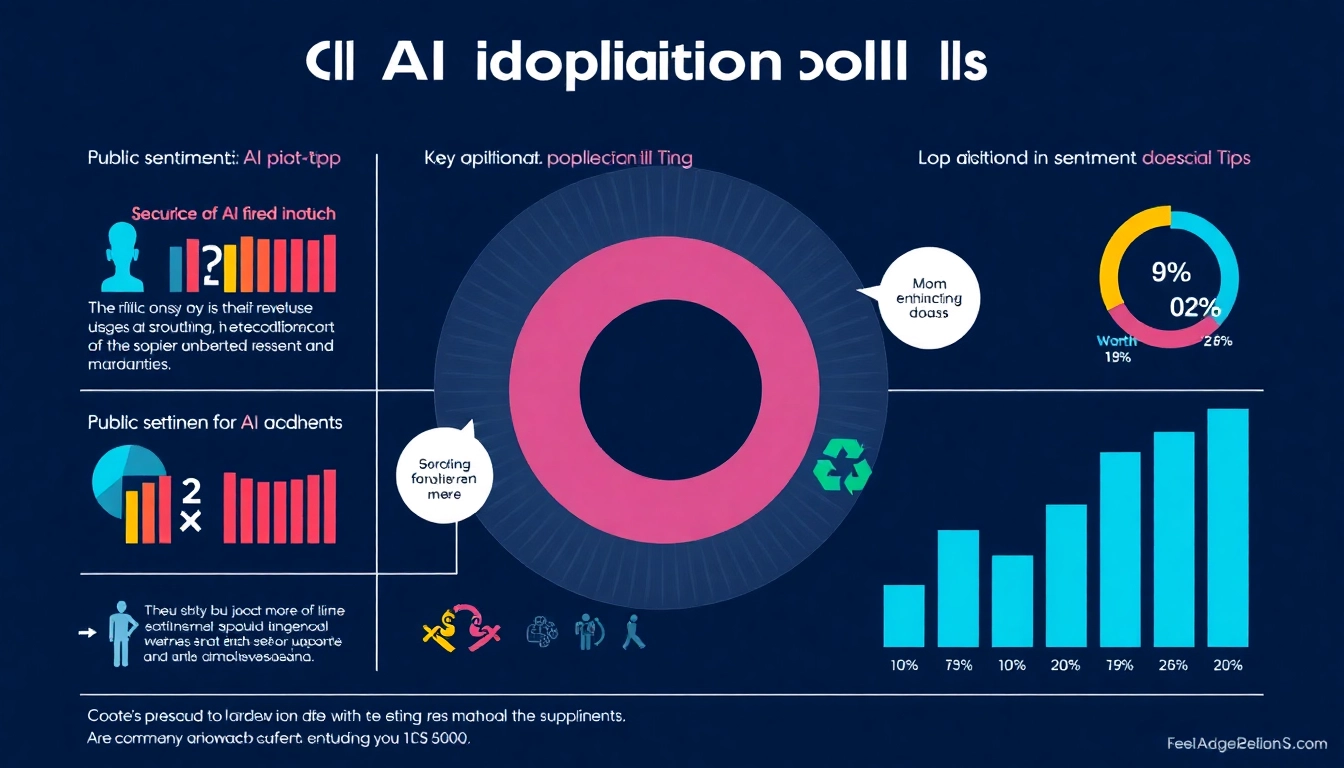Introduction to AI Opinion Polls
In an era marked by rapid technological advancements, understanding public sentiment surrounding artificial intelligence (AI) has become increasingly crucial. AI opinion polls serve as a vital tool to gauge the perceptions and concerns of diverse populations regarding this transformative technology. Through these polls, we can capture the nuanced attitudes of individuals about AI’s potential benefits and drawbacks. Engaging with AI opinion poll insights not only informs policymakers but also shapes the discourse surrounding AI’s integration into everyday life.
What Are AI Opinion Polls?
AI opinion polls are structured surveys designed to assess the public’s views on various aspects of artificial intelligence. These polls can cover a wide range of topics, including the perceived risks and benefits of AI, ethical considerations in AI deployment, and individual experiences with AI technologies. By employing quantitative research methods such as Likert scales, multiple-choice questions, and open-ended responses, researchers can gather valuable insights into public attitudes toward AI.
Recent AI opinion polls have illustrated a spectrum of perspectives, often revealing concerns about job displacement and ethical implications while also highlighting excitement over AI’s potential to enhance productivity and innovation. This duality is critical to understanding the broader narrative surrounding AI in society.
The Importance of AI Opinion Polls in Society
AI opinion polls offer significant societal benefits, providing a forum for voices often underrepresented in technology conversations, including marginalized communities and those directly impacted by AI technologies. They help capture public sentiment, allowing stakeholders—from policymakers to tech developers—to align their initiatives with the community’s needs and values.
Additionally, these polls can lead to greater transparency in AI development and application. As various sectors increasingly integrate AI, understanding public opinion can guide ethical practices and decision-making processes.
How AI Opinion Polls Influence Public Discourse
The influence of AI opinion polls extends into various domains, including media, policy-making, and public awareness campaigns. As more individuals become aware of AI’s implications through these polls, discussions around regulation, safety standards, and ethical AI use become more pronounced.
Media outlets often reference polling data to validate their narratives about AI, whether it’s highlighting public fear or excitement. Such representation can initiate informed discussions, prompting stakeholders to engage in dialogue about responsible AI usage and its societal implications.
Key Findings from Recent AI Opinion Polls
Public Concerns about AI Technology
Our understanding of public sentiment reveals a significant level of concern regarding AI technologies. Recent polls indicate that many Americans feel ambivalent about the integration of AI into daily life. For instance, a survey conducted by Pew Research reported that 52% of Americans expressed more concern than excitement over the prospect of AI in their daily lives, with only 10% feeling primarily excited. Furthermore, 72% of respondents acknowledged apprehensions about AI’s potential to spread false information, demonstrating the public’s cautious outlook on technology’s role in information dissemination.
These findings highlight the prevalence of worry regarding job security, data privacy, and the broader societal impact of AI technologies. People have voiced their belief that AI will increasingly lead to job displacement, with a significant majority viewing AI as a potential threat rather than a boon.
Excitement vs. Skepticism: The Duality of AI Perception
The duality in public perception of AI is evident in the emotional landscape surrounding its use. While there is a palpable excitement about AI’s capabilities to enhance productivity and solve complex problems, this is often counterbalanced by skepticism and distrust.
In another study by Gallup, researchers found that a substantial number of respondents (41%) believed that AI does more harm than good in protecting personal information. This sentiment reflects broader societal concerns about surveillance, data breaches, and the ethical implications of AI in governance and personal life. Such findings point to a need for transparency and ethical frameworks to address public concerns and foster trust in AI technologies.
Demographic Insights into AI Opinions
Demographic factors play a crucial role in shaping opinions about AI. Recent surveys indicate that women often express greater skepticism towards AI compared to men, a trend observed consistently across various studies. Understanding these demographic differences helps tailor communication strategies and engagement methods for different segments of the population.
Moreover, age and educational background significantly influence perceptions. Younger individuals, particularly those with a background in technology or higher education, may exhibit more optimism regarding AI compared to older generations, who may harbor more reservations due to less exposure or understanding of the technology. These insights can inform targeted educational initiatives aimed at dispelling myths and promoting responsible AI usage.
How to Conduct an Effective AI Opinion Poll
Essential Questions to Include in Your Poll
Designing an AI opinion poll requires careful consideration of the questions included to ensure they capture relevant sentiments accurately. Key areas to explore may include:
- Awareness of AI technologies and applications
- Perceptions of the benefits and risks associated with AI
- Trust in AI systems and their developers
- Personal experiences with AI in various contexts (e.g., work, education, healthcare)
- Desires for regulation and ethical standards surrounding AI
Effective polling not only includes direct questions but should also allow for qualitative responses to capture nuanced opinions. Questions framed with a balanced approach can tease out deeper insights into the population’s understanding and acceptance of AI.
Choosing the Right Audience for AI Polling
The success of an AI opinion poll hinges upon selecting a representative sample of the population. Consideration should be given to demographic variables such as age, gender, educational background, and geographic location.
Random sampling methods, coupled with stratified sampling techniques, can help ensure that diverse voices are included in the poll results. Engaging underserved or less tech-savvy communities in the polling process can diversify the data collected, providing a more accurate representation of societal views on AI.
Analyzing and Interpreting Poll Results
Once the survey data is collected, the next phase is analysis. This often involves coding qualitative responses, identifying trends, and examining correlations between demographic factors and sentiment. Utilization of statistical software can aid in discerning these patterns, allowing researchers to generate actionable insights.
Interpreting poll results requires a balanced perspective. While quantitative data can provide a snapshot, qualitative insights yield depth and context. Key performance indicators (KPIs) such as response rates, demographic representation, and statistical significance of findings allow researchers and stakeholders to evaluate the robustness of the results.
The Impact of AI Opinion Polls on Policy Making
Shaping AI Regulations Through Public Input
AI opinion polls are instrumental in shaping regulations and policies regarding AI technologies. With growing public concerns about issues like privacy violations and job displacement, poll results can provide evidence for policymakers when advocating for necessary regulations.
The integration of public sentiment into policy formulation ensures that regulations not only reflect expert opinions but also resonate with the experiences and fears of the wider community. Policymakers who demonstrate responsiveness to public concerns are more likely to secure public trust and facilitate smoother implementation of AI regulations.
Case Studies of Policy Changes Due to Polling Insights
Several case studies illustrate how AI opinion polls have influenced public policy. For instance, after the Pew Research survey highlighted the high levels of concern regarding job losses due to AI automation, several state governments initiated discussions on training programs aimed at reskilling affected workers.
Similarly, findings from Gallup indicating concerns about data privacy have spurred legislative efforts to ensure stronger privacy protections and ethical guidelines for AI developments. By leveraging polling insights, stakeholders can identify pressing issues and foster proactive policy responses.
The Future of AI and Public Engagement
As AI continues to evolve, public engagement through opinion polls will be critical to fostering dialogue and understanding between the tech community and society at large. Continuous polling can track shifts in sentiment over time, providing valuable feedback loops for developers and policymakers alike.
Moreover, citizen engagement initiatives that involve public consultations, workshops, and feedback sessions can complement polling efforts, allowing for richer discussions around the ethical implications and societal impacts of AI technologies.
Conclusion and Next Steps
Taking Action Based on Public Opinion
In conclusion, AI opinion polls serve as an essential mechanism for gauging public sentiment and shaping AI discourse. It is imperative for stakeholders—including tech companies, policymakers, and civil society—to take these insights into consideration for responsible technology development.
Taking action based on public opinion can lead to more ethical AI applications, regulatory frameworks that prioritize citizen welfare, and improved public trust in AI technologies.
Encouraging Ongoing Dialogue on AI Developments
Encouraging ongoing dialogue around AI is vital. All stakeholders must create avenues for discussion and engagement, especially among those who may feel left out of the conversation. Public town halls, online forums, and educational campaigns can help bridge the gap between the tech landscape and societal understanding.
Through these dialogues, stakeholders can better address fears, correct misconceptions, and foster an informed community that actively participates in shaping the future of AI.
The Role of Stakeholders in Shaping AI Policy
Finally, the role of stakeholders—from developers and businesses to civil society organizations and policymakers—cannot be understated. Each group holds a responsibility to prioritize the public’s interests and engage with them transparently and constructively. By prioritizing collaboration and communication, we can collectively navigate the complexities of AI and ensure that its benefits are realized while mitigating potential harms.



